
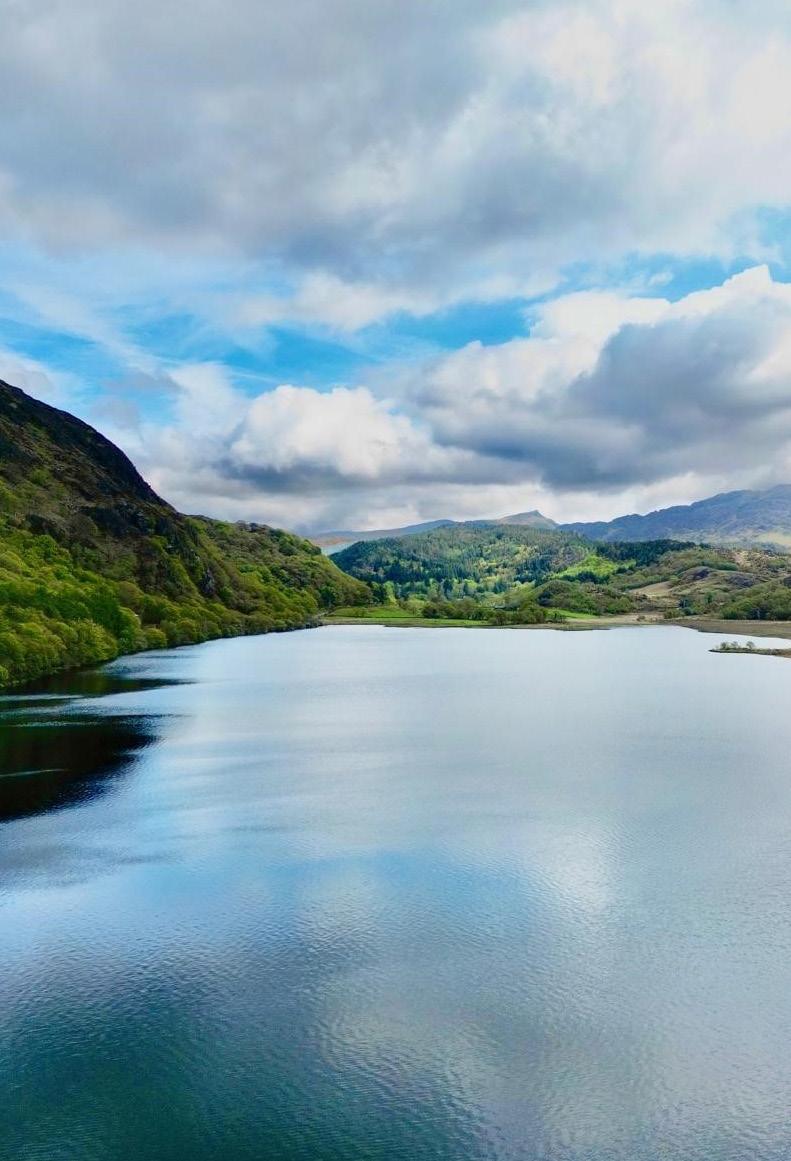
THe APRIL - MAY 2024 HAlF TERm 5
BAROMETER
Contents
Mrs Doubtfire: The MusicalMarty V, Year 9
Trib Drama 2024 - Ivan G, Year 12
Machinal Review - Ihsan A, Year 10
Why is Dystopian Literature So Perenially Popular?Edward J, Year 12
Barcelona Plaija D’Aro 2024Tommy S, Year 10
Science Week - Philip B-S, Year 7
Raf Simons: Teenage RiotElijah N, Year 11
Climbing Cnicht - Ethan G, Year 9
Pompeii - Bosco DeCalonje, Year 11
Soho - Moses N, Year 9
The Hong Kong RiotsBenedict S, Year 9
The Rest is Politics - Felipe E, Year 9
Carpentry - Toolbox - Oliver B, Year 13
Ramzi Boukhiam on the CTJack L, Year 11
A Preview on Euro 2024 - Saif M
Bayer Leverkusen’s Unbeaten Run to the Title - Breck R, Year 9
Cover photograph - Ethan G, Year 9
The 2024 Local Election Round Up - Oscar F, Year 12
Write for the Barometer
Contributing to the Barometer is a great way to earn gold notes, improve your writing, and it looks great on your CV
To submit articles or cover photos, join the Barometer club at Friday lunchtimes (B11) Or, you can email Mr s Bradley at nicola.bradley @wetherbysenior.co.uk
Read the latest issue at https://issuu.com/wetherbysenior
MRS DOUBTFIRE: THE MUSICAL

Marty V, Year 9 writes…
Mrs Doubtfire: The Musical is a play I wasn’t, at first, sure about as I usually prefer straight plays or dramas. However, I can confidently say after watching this wonderful performance, my love for musicals has reappeared!
In addition to the wonderful songs in the musical, the dialogue and story were on point. Everything that was said and sung to the
audience was easily understood, which helped with the enjoyment of the play - which hadn’t been the case when I saw Hamilton!
Let us talk about the amazing main characters. The leading role of Mrs Doubtfire is played by Gabriel Vick, a wonderful actor with many talents, but a particularly skilled voice actor. The funniest part of the play, in my opinion, was at the beginning, which caught me off guard. As
we all know, at the start of any production, comes a request that you put your phones away and on silent. This however was done very creatively in Mrs Doubtfire, when they had Gabriel Vick ask the audience to put their phones away in different movie characters’ voices. Vick was so amazing that he was able to recreate the voices of Yoda, Kermit the frog and Bart Simpson, to name a few.
Overall, he gave much light and energy throughout the play, making this a highly enjoyable watch. As I write this review, I am reminded of many hilarious moments all over again.
So, I would like to thank the cast and crew of Mrs Doubtfire and recommend this to anyone wanting an enjoyable two hours of great acting and laughter.
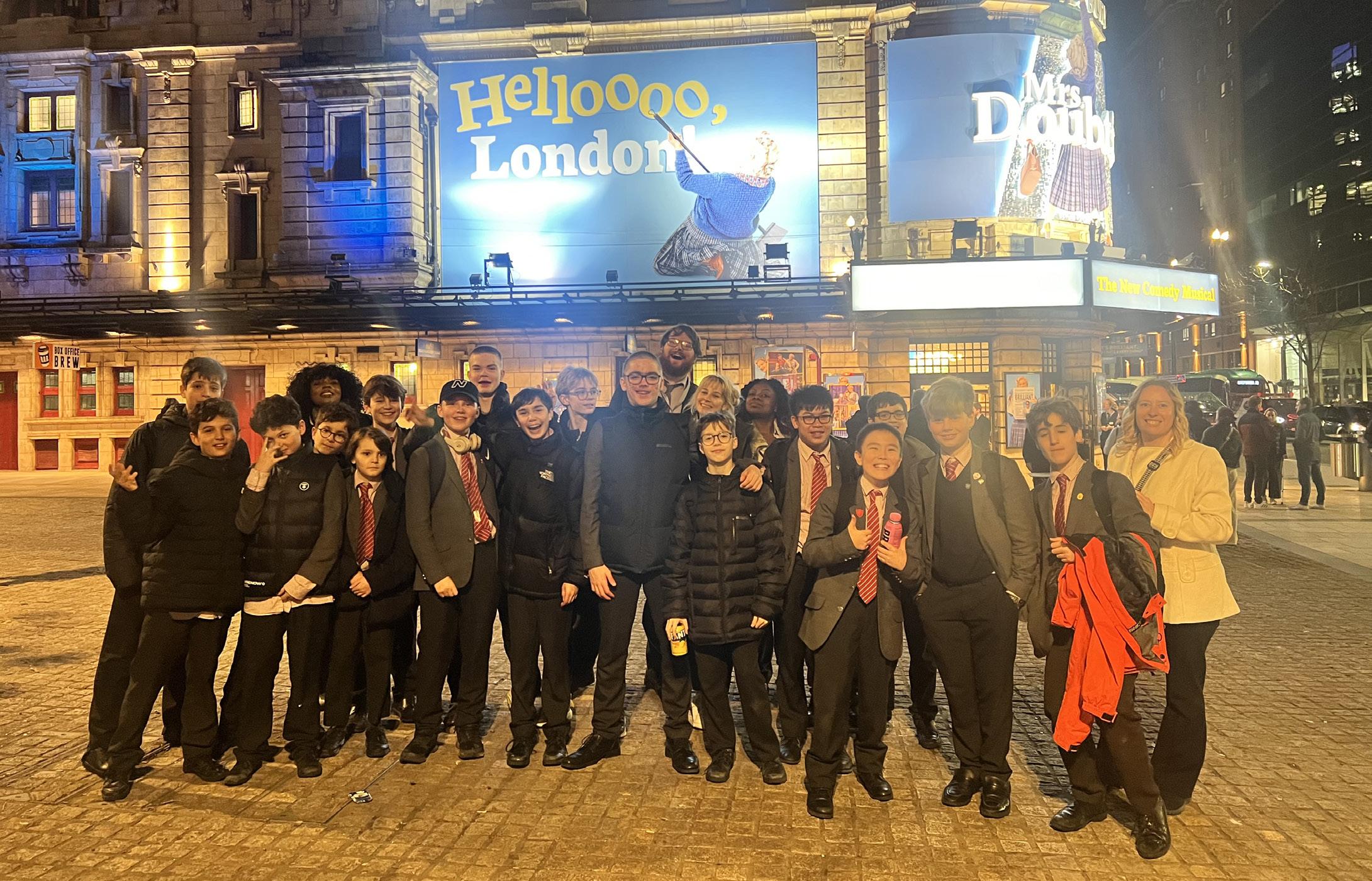
TRIB DRAMA 2024

For the past year, we, that is to say both the teachers and the learners that together form our school community, have been in deep collective thought, lining the long and empty corridors of Hannah House, Bulstrode, and Marylebone alike with scrutinising whispers on the subject of one important question: in its simplest formulation, ‘what setting could possibly be further from our Marylebone Lane Drama studio full of private-school students than last year’s Trib Drama prison set full of hard-boiled felons?’ The Amazon rainforest certainly is, geographically at least, and it must therefore take us by no surprise at all that an immediately immersive performance space covered with bottle-green foliage and soaked
in lemony, student-designed lighting is the kind of enterprising eccentricity our virtuoso Head of Drama Miss Twomey had planned for this year’s fiercely competitive inter-Trib extravaganza.
With a title somehow suggestive of the potential for both anti-industrialist satire and environmentalist rhetoric, Seb Wolff’s Amazon script quite appropriately comes down in favour of neither, opting for a rather generic brand of farce well suited for just about every year group in attendance as well as their parents, though it would be unfair to pay no heed to the odd, outstanding moments of relevant social commentary scattered throughout the many easy laughs. These come mostly in the form of zany one-liners revealing the
duplicity of Milton Prince, a character whom Wolff here writes, respectably, as a caricature of our own era’s two-faced ‘content creators’ and who is brought into performance especially well by Tyburn’s Theo N with a distinctive series of quasi-Brechtian poses and pseudo-fourth-wall-breaks. The fact then, that, spoiler alert, Amazon ends with our characters collectively staging a metatheatrical scene of danger for Prince’s vlog betrays the presence of some intriguing yet suppressed sociopolitical criticism, suggesting that the intellectual substance of our Trib Drama productions is on a rapid increase, compared with 2023’s Cockroaches. Who knows? Next year’s performance may yet bring forth unheard of existentialism.
What Wolff’s script must no doubt be praised for, though, is its shrewd inclusion of both the former Head Boy of some unstated school (private, surely) and a schoolteacher of some similarly unstated subject (Geography, methinks) as part of its six-man
 Ivan G, Year 12 writes...
Ivan G, Year 12 writes...
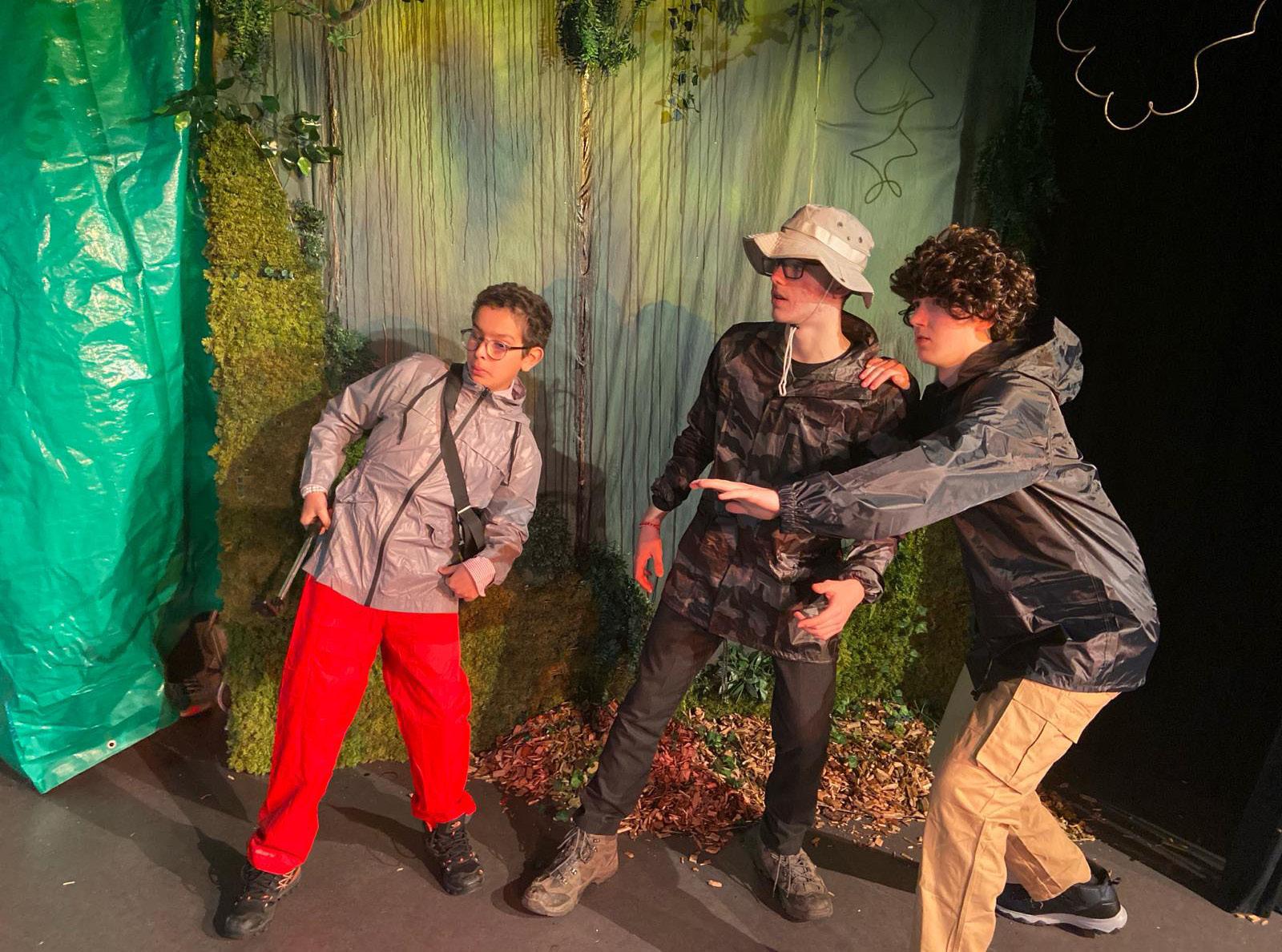
line-up. With these two astutely chosen personalities juxtaposed onstage, the boundaries separating performance from reality, script from school, and the teacher from the taught are temporarily clouded, allowing for genuinely effective comedy tailored admirably to both the audience members watching and the students performing. The production can thus be seen to flourish, through perceptive character choices and, subsequently, casting, when current Head Boy candidate Oscar F, in character as conceited Wallace Churchill, proudly points out that he was once Head Boy
before stepping aside to let Alex L, apparently playing Eric Winstanley the buoyant, fictional teacher, go off script, crying out in no uncertain terms that he is afraid of Mr Hayes. Was this sudden addition a break in character?
A Freudian slip, perhaps? Or an intentional provocation; an instance of surrealist meta-theatre and Brecht’s V-Effekt employed conjointly? Either way, with such self-aware direction from actual Head Boy Paul C, in addition to something of an Artaudian assault on the senses from A-Level Drama student Christos L during his noteworthy, explosive entrance through the audience, Fleet’s well
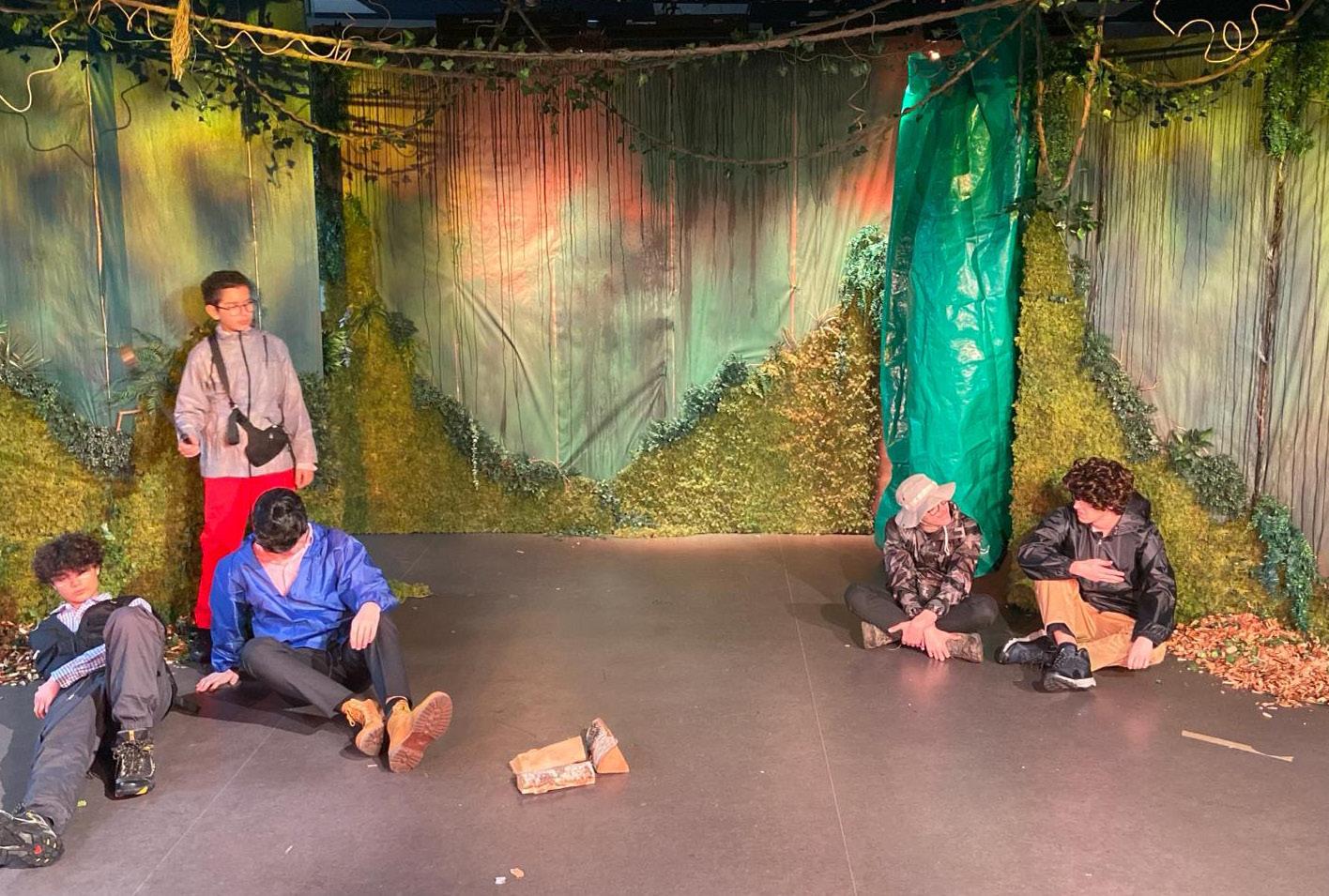
earned win was written in the stars, and not because they have the Heads of Drama and Sixth Form in their Trib.
Last year, we watched tensions rise within the confines of a prison; the year before that, in a hotel, and, this year, on a tour through the wilderness, each time finding ourselves immersed, upon the same red chairs, in environments ever more detached from our own Marylebone Drama Studio, and yet what stood out this year amongst the props and the greenery was how the production

onstage reflected the things we care about as a community. In this case, more than anything else, even perhaps than social commentary: Mr Hayes as an object of fear. Let us then hope that next year’s set metamorphosis will herald some new, higher kind of Wetherby Senior School Trib Drama production. In the meantime, in our corridors, we will speculate: what next, what now, which teacher next will appear before our eyes?
MACHINAL REVIEW
Ihsan A, Year 10 writes...
On Wednesday 15th May 2024, Year 10 Drama GCSE class were delighted to have the opportunity to attend The Old Vic to watch Machinal. It follows the life and dramatic journey of a woman called Helen Jones, who is ‘pushed to breaking point by the relentless machinery of life, expectation and convention’ (Old Vic website).
This intrigued me as a member of the audience, and I was captivated with the plot twists and journey of Helen’s life, and was surprised by her ultimate demise. The opening
scene set the pace for the rest of the play with an extraordinary moment introducing the main character and her current lifestyle. What particularly impressed me were the smooth transitions between scenes to switch to a new chapter of Helen’s life. The acting was very professional with the different character traits presented thoroughly to the extent where the audience would almost feel uncomfortable in the presence of some characters. The emotional rollercoaster of Helen’s life was brilliantly presented in a fitting acting style. Complementing this amazing acting performance,
the sound effects and music were perfectly fitting and really added to the overall performance, enhancing the emotions presented on stage. As an example of something that stuck out to me, the scene of Helen in court was lit by white lighting that shone over the audience, putting us in the position of spectators in court. This idea was further explored when the actors broke the ‘fourth wall’ to interact with us in many different ways. Personally, I thoroughly enjoyed the experience and felt lucky to attend.

WHY IS DYSTOPIAN LITERATURE SO PERENNIALLY POPULAR?
Edward J, Year 12 writes...
Audible’s recent dramatization of 1984 – boasting a star-studded cast of narrators that ranges from Tom Hardy to Andrew Garfield – is one of many examples that highlights dystopian literature’s ubiquitous and prevailing appeal. Why is it that dystopian literature has remained such a voguish genre? Is it simply a subset of the human condition that revels in the grim prospect of suffering? Or is it, rather more sinisterly, a horrifying reflection upon the hopelessness of our times?
But what even is a “dystopia”? Well, it is defined as being an imagined state or society –typically totalitarian or postapocalyptic - in which there is great suffering or injustice. It is a genre that has produced numerous literary blockbusters: 1984, The Handmaid’s Tale, Brave New World, A Clockwork
Orange, The Hunger Games, and the list goes on. This relatively recent explosion of interest is a stark contrast to the utopian genre that can be seen making up the very roots of literature. Whether it be the political utopia of Plato’s “Republic” or Iambulus’ “Islands of the sun” the pervasive theme was one of striving for an improved existence. It is generally accepted that the antithesis of utopian literature –dystopian literature – developed in the late 19th century with H.G. Wells’ “The Time Machine”. This work evidently captured the imagination of the society of its time, clearly hungry for a different form of sublimation.
The cause of this shift is multifaceted. It may be that people are drawn to dystopias because they offer a reflection of current anxieties and struggles, making them feel - rather depressinglymore tangible and realistic than
any utopia. On the other hand, it could be argued that our society – a utopian idyll compared to centuries ago - does not feel the need to yearn for a hopeful far-off future. In truth, the answer likely lies somewhere between the two. Everyday, we see incredible joy but also unimaginable suffering, staggering wealth yet also immense poverty - all coexisting in a complex tapestry of human existence.
Ultimately, readers are left with the agonising conundrum as to how close - yet so, so far away - we are from a real utopia. Indeed, this raises an extremely convoluted question that ought to be answered another day: would a novel about our current-day society be a utopia or a dystopia? And, perhaps most fascinatingly, how would that opinion change over time?

BARCELONA PLATJA D’ARO 2024

Tommy S, Year 10 writes...
In our most recent trip with Wetherby Senior, Year 10 and Year 9 had the fantastic opportunity to develop their football skills abroad. It was an amazing experience, not only to play against a more diverse set of football teams but also to get a taste of Spanish culture.
The trip was over the space of four days, however all of the pupils wished it could have been longer! The first day began early as the flight to head to Barcelona was at 7.30. After a serene flight, we arrived in Barcelona. From there we took a coach that brought us to the striking views that Sant Jordi had to offer: a remarkable azure sea, sand tinted with orange, and glorious blue skies, and all only five minutes away from our hotel.
On the first day, we all enjoyed visiting the city and exploring our hotel. On the second day we took a coach to a phenomenal Astro 3G pitch for our first training session,
where we had the opportunity to train with Spanish coaches who showed us their unique style of play. Shortly afterwards, we went back to the hotel and ate some appetizing Spanish food. We didn’t have a match that evening so we took the opportunity to head to the beach where we played either football, volleyball or had a swim in the sea. That night we enjoyed ourselves, heading to the bowling alley and relaxing before our first match the following day. The following day we had our second training session with a different set of coaches; again, it was really interesting for all of us to see the way that other international coaches taught.
We headed back to our rooms where we relaxed a bit before we hopped on a coach which brought us to our first match of the trip. It was a very successful evening for both A and B teams as we played a local club and won 5-0 and 4-0 respectively. We enjoyed our coach ride back to the hotel as in the evening we were in for a
chill evening in our rooms. On the second-to-last morning we were delighted to know that we were going to the beach again, where we enjoyed a casual kickabout. Once finished, we went back to our hotel, ate some food and then took the coach to play our final match of this trip. It was an emotional moment for all of us as it was our last match of this remarkable trip and also our last match playing all together. The pitch was astounding: it was in a stadium, but it was the backdrop that truly took our breath away, where towering mountains rose dramatically in the distance, their peaks dusted with snow that gleamed under the sun. We tried to take as much as we could from this experience of playing in a football stadium; our B team had an unlucky game and unfortunately lost, however it did not overshadow their sensational first match. However, our A team stole the show, ending their Barcelona journey in a 3-1 victory against a well-drilled side. While celebrating with joy, we headed to
a pizza restaurant where we had a quick dinner before heading to a nightclub.
This experience was organized by all of the remarkable Wetherby Senior staff who agreed to book a nightclub with two other British schools that were staying in our hotel. We arrived on the final day, all of us with very mixed emotions as we were joyful as we had a fantastic time that we will remember for the rest of our lives but also sad that we needed to leave this beautiful place. However the day was not finished there.
We took the coach to Barcelona where we enjoyed a visit to the FC Barcelona museum and had a great time roaming around the famous Ramblas, eating some proper Spanish street food. After all this experience it was time for us to fly back to London. However on behalf of all the people that went on this Barcelona trip, I just want to say thank you to all
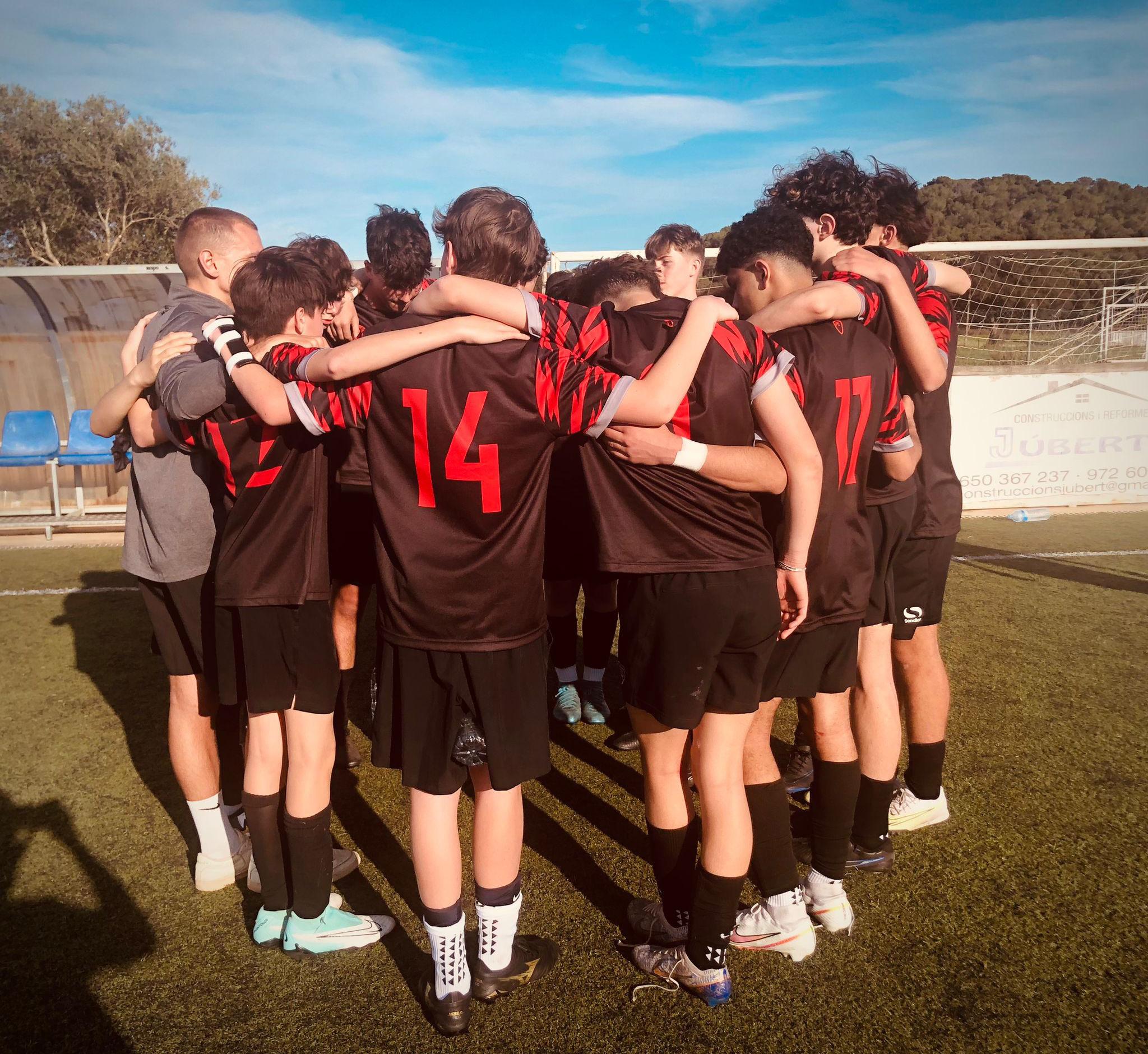
the amazing Sports Department that organized all of this trip for us, allowing us have one of the best time of our lives. You are all fabulous teachers and I cannot emphasize enough how happy
I am to be taught by you and to have been on this amazing trip. Thank you all for organizing all of this and it has been a pleasure to get to know all of you outside of school!

SCIENCE WEEK
Philip B-S, Year 7 writes...
Science week was an excellent way for students at Wetherby to express their scientific talents. We had so many activities: trivia quizzes, debates, talks on stereotypes about science, etc. Every activity included teamwork, knowledge and great fun!
Trivia
In this activity, we all teamed up to do an exclusive quiz made by Miss Johnson. The winning team received a chocolate of their choice from a celebration pack.
Debate: Good or bad animals
There were two teams, each with 3-7 people. Each team would have a set animal (e.g. snake, rat, etc.).
Both teams would choose why the animal is good and the other team would try to counter their argument and say why that animal is bad and should not exist. The winning team again would receive a chocolate of their choice from a celebration pack.
Stereotypes
in countries
Many counties have unfair and horrifying stereotypes that effects how they are perceived (e.g. Brazil has been impacted by stereotypes calling them violent because they have a high crime rate). These stereotypes also have major effects like leading to conflict between countries. People have also been shamed because they are from a country affected by stereotypes. The task asked us to create an
advertising campaign about a stereotypically “dangerous” country.
Summary
Science week has changed the school environment. Younger years socialised with older years, causing the new joiners to feel safer near older years and making them seem less intimidating to us.
As part of Science Week, Miss Johnson ran a Science Photography Competition. Joint first place went to Misha M, Year 10 and Elyes B, Year 8 with Alex L, Year 9 receiving a Highly Commended award.



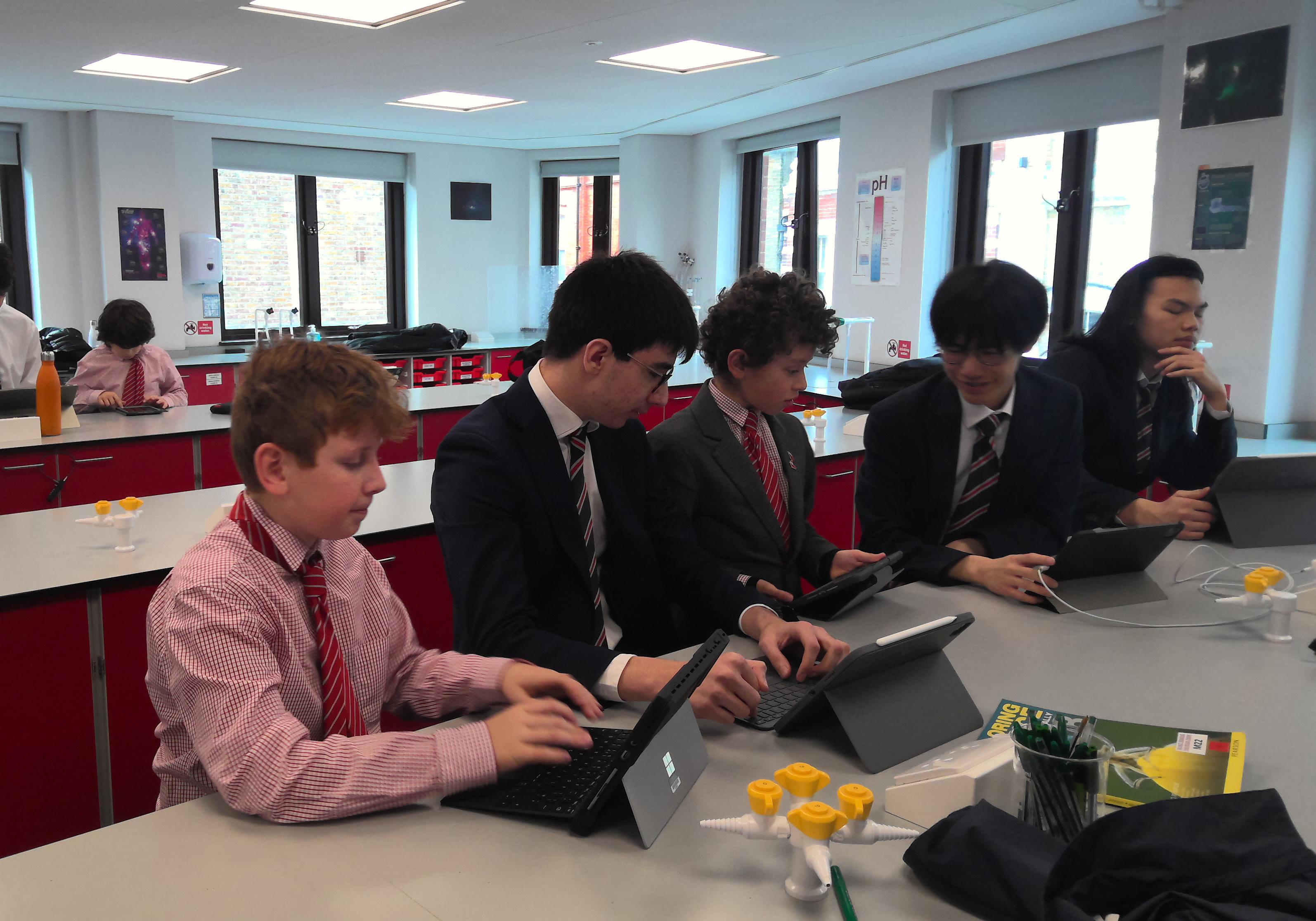

RAF SIMONS - TEENAGE RIOT
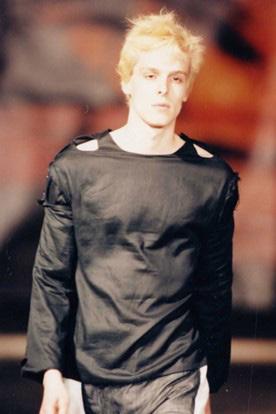
Elijah N, Year 11 writes...
The Belgian designer Raf Simons explores teenage angst in his nostalgic and striking works. Similar to the punk designs of Westwood and Demeulemeester, he pioneered his brand with the “Riot! Riot! Riot!” AW 2001-2 collection evoking the clamour and individuality of youth through motifs such as burning torches on the runway, camo print, and 90s ‘New Wave’ memorabilia.
Raf merges the messiness of youth with the sleekness of luxurious fashion, often sewing post-punk badges onto fine merino wool sweaters, as if he is taking away from the bourgeois and giving it all to us: the future. But why? I think it’s because his fashion

functions as a metaphor for the alienation many teens feel day-today. Personally, I see this “war” as a symbol for the corruption we are born into and must fight against. It is almost like Raf equips us with ‘weapons’, empowering us to
embrace our human condition.
May the Circle Be Unbroken His pivotal collection must be the SS 2004 “May the Circle Be Unbroken”. It was inspired by Herman Hesse’s
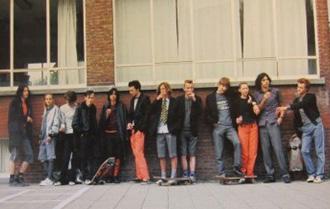


Above: “Riot! Riot! Riot!” jumper: post-punk embroidery and Joy Division as the central emblem.
Below: The accessories of the collection.

‘Siddhartha’, a story about teenage enlightenment, and Raf especially documents his own journey in this collection.
My take on it is that it conveys the persistent struggle of youth to grow these layers of identity and find our own enlightenment along the winding road of life. Here, many of the accessories have religious symbology, such as the Buddha and the hand representing spiritual disobedience, and models were seen walking barefoot through grass, some only wearing pants. Nature also plays an important role in Siddartha, exploring our connection with the natural world. Is this perhaps a commentary on consumerism?

Or is Raf suggesting that we must channel our internal creative voices, forming a rebellion against modernity?
Ultimately, I believe that somewhere along this road that Raf highlights with timeless designs, we gain an understanding of the importance of defiance and exposure to the arts that mould the way we think. Life is short, especially our youth: “Too fast to live, too young to die”.
Sadly concluding the brand in 2023, Raf will always remain one of the most pivotal designers for both the industry and our complex generation.


CLIMBING CNICHT
Ethan G, Year 9 writes...
Cnicht in the Moelwynion Hills is one of the most popular mountains in Snowdonia to climb outside of the Snowdon Massif, as this area alone attracts over 75% of the area’s visitors each year. It was for this reason that we decided to ditch our original plan of completing the Snowdon Horseshoe alongside the infamous knife-edged arête of Crib Goch. Instead, we decided on an arguably more strenuous route up the Matterhorn-shaped peak of Cnicht. The walk up from Croesor is reasonably straightforward for the average hill walker, while the keener walker (like me) would look to couple it with the nearby Moelwyn Mawr or descend via a portion of the 80+ mile long Snowdonia Slate Trail back to
Croesor Car Park. We picked this option due to the increased length rather than increased elevation gain (2000+ meters if you go from Beddgelert and link the route over Moelwyn Mawr). The hike was very enjoyable overall and I actually think that I would have enjoyed more than either the Pyg or Miners path up Snowdon (all of which I have done) if I hadn’t been suffering from the tail end of a cold. In terms of exposure (not overall difficulty), I would place the amount of exposure during the hike on the same level as the CMD Arete on Ben Nevis (minus the actual arête, although it is another great trip) as it is quite airy and exposed in the same way nearer the summit. However, I can’t rate difficulty as it will vary massively depending on the person.
Overall, I would 100% recommend this route to anyone with moderate climbing experience and competent grade 1 scrambling skills (11-15km to cover in 6-8hrs depending on route finding), as well as the ability to navigate using a traditional azimuth ring and compass or a dedicated GPS device as there is no service on many parts of the climb and no path during the second quarter of the route.
Right: Halfway up the ascent with the summit of Moelwyn Mawr in the background and the remnants of the old slate mines deep in the valley below.
Below: One of my favourite aerial shots of all time

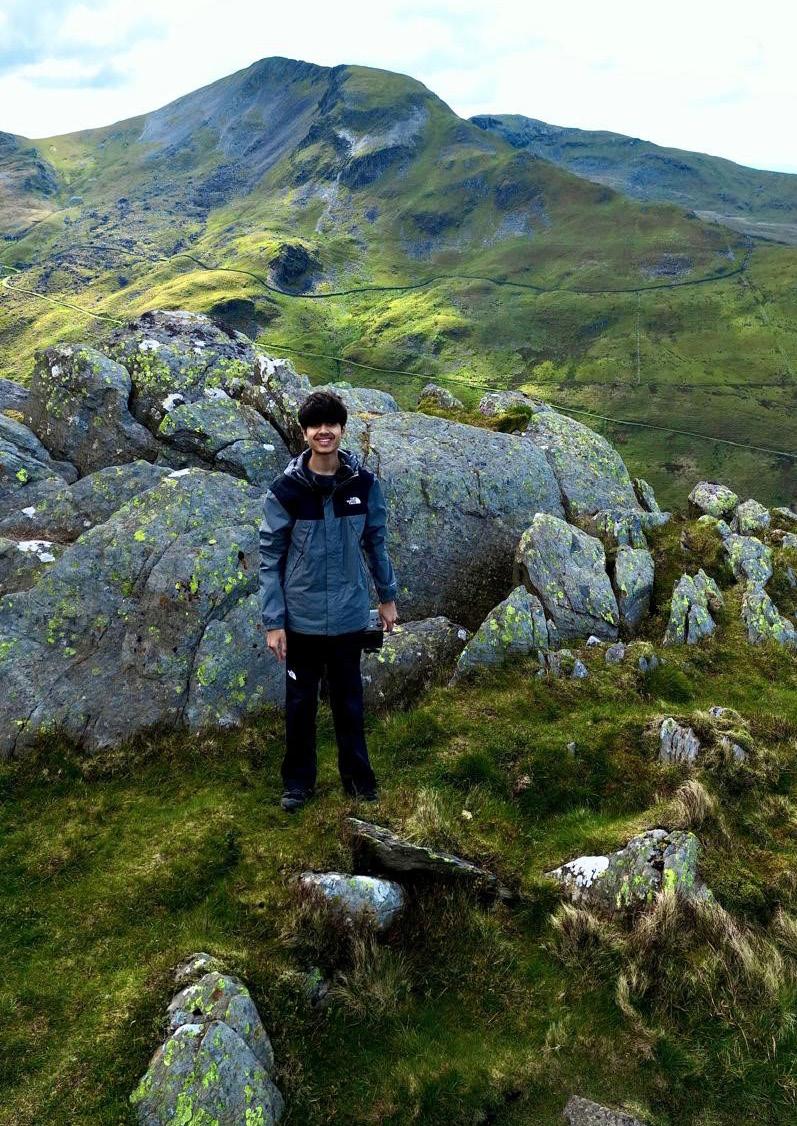
POMPEII

Bosco D, Year 11 writes...
Last half-term I was lucky enough to visit Rome and it gave me the opportunity to visit the archaeological site of Pompeii. Pompeii was a Roman city which was wiped out as a result the volcanic eruption of the nearby Mount Vesuvius, in 79 AD. The ruins of Pompeii were first discovered in 1549, but when excavations began in 1748, the significance of the site was shockingly revealed as thick layers of ash covered Pompeii preserving frescoes and inscriptions to an astonishing degree. Thanks to this, Pompeii has been an invaluable asset to classicists and archaeologists wanting to learn more about Roman culture, society and art.
Since I am interested in art history, classical civilisations and study Latin, I was captivated by the surreal vibrancy and the detailed scenes on the walls of the houses that also gave insights into the lives of the Roman
citizens. For example, one which I particularly was drawn to, was the frescoes on the walls of a bedroom in what is known as “The House of the Fruit Orchard”. Usually cubicula, (bedrooms) were small and rarely used except for sleeping, yet the exquisite decoration on the walls of this cubiculum took me by surprise not only due to its location but also the ancient Egyptian motifs present. There were records of Roman worshippers of Egyptian gods such as the Isiaci, but to see the blend of mythologies in this lush garden scene was magical.

Moses N, Year 9 writes...
There are many a place in Soho that can catch your eye, with lots of back alleys and miscellaneous shops. Soho is adjacent to Covent Garden and only a 15-minute walk from the famous red doors of Wetherby. Yet it is like another world.
Soho was once farmland turned into a royal park where nobility could hunt, by Henry VIII. Its name originated from a hunting cry in the Tudor era. The area was aimed at the nobility after it the park was converted into houses. However, the nobility much preferred Mayfair, which led to writers and artists living in Soho, most of whom were French. This influx of writers and artists led to the creation of the west end in the early seventeen hundreds.
As time went on, Soho continued to grow, and in the 20 century it became a social hub. Many famous musicians have early performances there such as David Bowie, Led Zeppelin, The Rolling Stones, and many others. Many artists also liked to frequent Soho, including Francis Bacon and Lucian Freud and Damien Hirst. Even Mozart used to hangout in Soho.
This leads up to today where Soho is popular amongst the youths of London for its street wear fashion, nightlife, and the aura that it produces. However, there are many hidden away aspects of it.
There are many shops in Soho, and many are tucked away however these are my top three Cafés to visit:
The Algerian coffee stores, which has been in soho since 1887 and is a fantastic place to visit with the amazing atmosphere and pleasant staff.
Bar Italia, Italy in the midst of Soho which has been a cultural hub and is open late into the night.
Supernova, a small burger diner which has recently been established in Soho. Supernova only serve cheeseburgers, fries, sundaes, and drinks.
There are also other shops in Soho, these specifically include fashion shops which include street wear and other popular brands.
Liberty, the world-renowned beauty, and fashion boutique which is responsible for displaying some of the world’s most prominent designers.
Supreme, founded in Manhattan in 1994, it moved to Soho in 2011. Supreme is a street wear brand which originally was a skateboard shop. It has made many influential collaborations.
Despite Soho’s rich history as a hub for arts, revelry, and latenight entertainment, it remains an iconic area known for its vibrant restaurant scene, bars, and clubs. It’s an unexplored world.
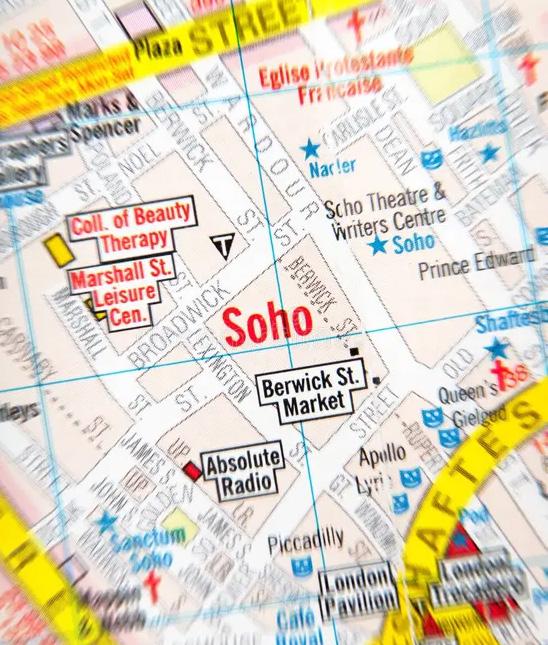
SOHO
THE HONG KONG RIOTS
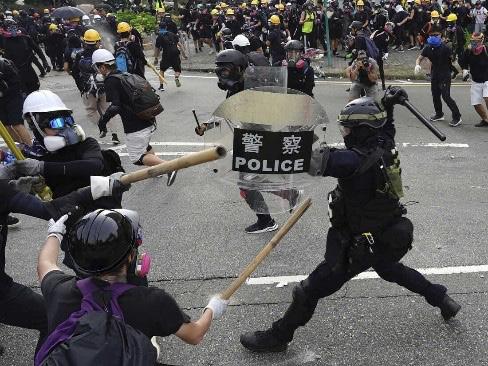
Benedict S, Year 9 writes...
The Hong Kong riots, a periodof civil unrest that began in 2019, marked a critical juncture in the region’s political landscape. The immediate trigger was the proposed extradition bill, officially known as the Fugitive Offenders and Mutual Legal Assistance in Criminal Matters Legislation (Amendment) Bill 2019. This bill, if passed, would have allowed for the extradition of suspects to territories with which Hong Kong did not have extradition agreements, including mainland China. Many Hong Kong residents saw this as a direct threat to the region’s semi-autonomous status granted under the “one country, two systems” principle agreed upon during the handover from Britain to China in 1997. The fear was that the bill would subject Hong Kong citizens and visitors to the opaque and politically motivated mainland Chinese judicial system, undermining the region’s judicial independence and civil liberties.
As the government pushed forward with the bill, massive protests erupted. These protests quickly escalated from peaceful marches to include violent clashes between the police and protestors. The police response, which included the use of tear gas, rubber bullets, and later
live ammunition, was widely criticized internationally for its severity, and raised serious human rights concerns. The protestors, meanwhile, employed a strategy of “be water,” a philosophy of adaptability and unpredictability, which involved moving quickly and dispersing to avoid prolonged confrontations with law enforcement. The movement also broadened its demands to include greater democratic freedoms, such as universal suffrage, and an inquiry into police brutality. The protest movement was notable for its leaderless structure, relying on social media and apps to coordinate actions and spread information.

The protests led to significant political and social consequences for Hong Kong. In September 2019, in response to the intense public pressure, Chief Executive Carrie Lam officially withdrew the extradition bill. However, the protests continued, fuelled by broader issues regarding governance and police conduct. The situation was further complicated by the global outbreak of COVID-19 in early 2020, which reduced the scale of public gatherings. The Chinese
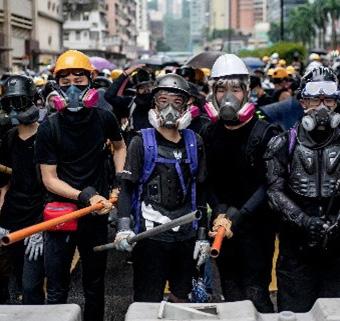
government’s imposition of the National Security Law on Hong Kong in June 2020 marked a significant shift. The law criminalized acts of secession, subversion, terrorism, and collusion with foreign forces, leading to a dramatic reduction in protests due to fears of arrests and lengthy prison sentences. Several prominent activists were detained or went into exile, and numerous pro-democracy organizations disbanded.
In conclusion, the Hong Kong riots of 2019-2020 were a landmark moment in the region’s history, reflecting deep-seated fears about the erosion of civil liberties and judicial independence under increasing Chinese influence. While the withdrawal of the extradition bill was a tactical victory for the protestors, the subsequent imposition of the National Security Law signalled a substantial curtailing of Hong Kong’s autonomy and freedoms, fundamentally altering the fabric of Hong Kong society and its political landscape. The legacy of these protests continues to impact the region, as the struggle for democracy and local autonomy remains a poignant issue in the face of stringent controls.
Felipe E, Year 9 writes...
The Rest is Politics is a political podcast that launched in September 2022. Its hosts, Alistair Campbell and Rory Stewart have a large amount of experience in the political world. Campbell was Tony Blair’s Head of Communications for six years and was also his speechwriter. Rory Stewart was a member of the conservative party in Parliament from 2010-2019 and served in many roles in two successive Conservative Party governments, under David Cameron and
THE REST IS POLITICS
under Theresa May. He then left Parliament and the Conservative Party after the 2019 election.
On their show, part of the Gary Linekar-owned stable of Goalhanger podcasts, they talk about the leading news stories of the day and the stories behind them once a week. They also do a question time, where they invite listeners to send in questions for them to answer on the Podcast. They are mostly around 45 minutes or so. You do also get the odd emergency podcast, when there is a massive breaking
news story. I myself really enjoy listening to the podcast, as you get both sides of the argument and also some history behind it. For example, when the Israel-Hamas war started, Rory did an explainer on it that got 1 million+ views on YouTube and other social media platforms. Alistair Campbell notoriously hates Boris Johnson, so any podcast with Boris-bashing tends to go viral.
If there are any people interested on getting another view on the days leading stories, then this podcast is for you!

THE 2024 LOCAL ELECTION ROUND UP
Oscar F, Year 12 writes...
In an earlier edition of the Barometer, I commented that the once-mighty juggernaut of the Conservative party had hit its iceberg; it has now well and truly sunk.
The headline results of the recent local elections are stark for the Tories: they now control only 19% of seats, slipping to third place behind Labour and the Liberal Democrats in their worst election night since 1997. They lost in areas like Lincolnshire and Oxfordshire whilst their vote share reached historic lows in Trafford and Sefton – areas that they previously would have considered themselves in the running come a general election.
By contrast, Labour’s lead has shot up to 48% and the results do demonstrate that the cogs in Labour’s campaign machine are working faster than ever. Crucially, their best council results were in their target constituencies for the election, in places like Hartlepool and Hyndburn, and their resources were divided perfectly between the difficult balance of local councils, mayoral races and police and crime commissioners. Keir Starmer has taken an entirely new approach to the Labour campaign. You might have seen some of the leaflets posted through your letterbox, and while it might not have been instantly obvious, they look very different to those of the Corbyn era of the party. From edge to edge, they are plastered with union jacks, bold red branding, and blown-up images of Keir Starmer, representing his vision
of a changed Labour party that is proud of our national identity and sees its leader as a genuine prime ministerial candidate.
Keir Starmer should, however, take pause before he hails his taxi to Downing Street. Under Tony Blair, the party’s lead was at 62% in a comparable election, and ultimately the party suffered losses in traditional heartlands like Oldham. They lost to the Liberal Democrats in Hull and only just edged it from the Tories in Harlow – while the big picture for Labour is undoubtedly positive, there are cracks that could begin to grow.
The biggest reason behind this was the resurgence of the independent vote. For example, in the West Midlands, Labour’s Richard Parker beat Andy Street by only 0.3% of the vote, however, Akhmed Yakoob, an independent candidate, won a decisive 12%. It is accepted that the vast majority Yakoob’s vote would under normal circumstances have gone to Richard Parker – but the issues in Gaza, an area over 2000 miles away, and discontent with the Labour position, had an extraordinary impact. In fact, independents now have control
of over 228 local council seats and caused Labour to lose overall control of a host of councils in their heartlands. Some political pundits have questioned whether this trend will continue in this year’s general election: people often feel emboldened to vote for an independent or minor party candidate in local elections, and return to what they might think of as the ‘lesser of two evils’ come the general elections. This is certainly a trend backed by data: the Green Party currently holds just one seat in the House of Commons, only 0.001% of all available seats, compared to 0.05% in local councils. Not a lot either way, but politics is a game centred around the details.
More widely, however, the results of the mayoral elections also pose interesting questions for the future of British politics. Labour now controls eleven of the twelve metro mayors in the country, but how far they would tow the party line under a Labour government is a contentious issue: even in his victory speech Andy Burnham, the Mayor for Manchester, emphasised that his policies were, and would continue to be, ‘place first, rather than

party first.’ Mayors are becoming increasingly central players in the political landscape, and in-turn are demanding increased powers, whether it be over tax, or further devolution of public services.
Perhaps even more interesting analysis can be seen in attempts to project results from the mayoral elections to the general election later this year. It is truly significant that Ben Houchen was the only Conservative candidate able to retain his mayoralty, gaining 54% of the vote. This was a sharp drop on the 73% of first preference votes he won in 2021, but still comfortably enough to defeat his Labour rival. There is evidence to suggest that it was Houchen’s personal brand that saved him – local elections in his area saw both the Hartlepool council move to Labour control and the Conservative Cleveland police and crime commissioner lose out to the Labour candidate. By contrast, Andy Street could not perform the same trick, try as he might. It appears that the falling popularity of the Conservatives cost him his mayoralty, despite his own strong profile, having previously won the mayoralty with 49% of first preference votes in 2021.

Overall, the recent local election results demonstrate a profound shift in our electoral debate: the question is not whether Labour win but rather how much will Labour win by. Rishi Sunak’s postelection broadcast was genuinely jaw-dropping in this regard. Traditionally, the Prime Minister would take to the airwaves and give some well-rehearsed lines about “listening to the voters” while assuring everyone that “all isn’t lost”. Instead, Sunak’s first words were that Labour was headed to form a minority not majority government – he simply admitted defeat when considering that every party in Parliament has now ruled out a coalition with the Tories.
It is clear that Rishi Sunak’s political machine has ground to a halt, its engine is sputtering and in desperate need of repair. Despite endless U-turns, nothing seems to help. He lacks Johnson’s pageantry, the perceived competence of Cameron or even the determination of Thatcher. His failure to make a name for himself means that come November, his name is on course to be forgotten in the ebbs and flows of politics, forever a caretaker prime minister that kept his ship on the same course to defeat.

CARPENTRY - TOOLBOX
Oliver B Year 12 writes…
I have always been interested in engineering and passionate about hands-on practical work to support the theories we learn in class. The Wetherby Art & Graphic Design Department were incredibly supportive in letting me satisfy my supracurricular interest, while also giving me the opportunity to supplement my university personal statement. The prelude in Professor Thomas Povey’s book on puzzles and problems inspired me to take the initiative – like a younger him –to embark on some of my own projects. Books about successful Formula 1 engineers had sparked the idea before, but Professor Povey (an Oxford engineering graduate and current research fellow) really emphasised how much one can learn from the process.
Feeling like Adrian Newey, the great aerodynamicist for Red Bull Racing, I handed Mr. Murphy my initial blueprints for a wooden toolbox. I thought this would be an appropriately simple first venture. It was a privilege to work with Mr. Muphy; his extensive experience with steel and marble, both significantly trickier than wood, was invaluable. He first taught me the importance of making a foam model to visualise dimensions and any practical issues before committing to the real thing.
One of the highlights was using the band saw, which required great precision for a smooth and straight cut. As with most projects, we encountered a small hiccup when we noticed that the structure
may have been too weak to support heavy tools. We resolved this by developing pillars to drill into the inside of each corner for a more robust design. As Mr. Murphy always says, “it always
takes longer than you think.”
Following several hours of afterschool sessions, it was immensely fulfilling to finally apply the varnish and finishing touches as we successfully concluded the


RAMZI BOUKHIAM ON THE CT

Jack L, Year 11 writes...
Ramzi Boukhiam is a surfer from Morocco who has been in the challenger series (the level just under the championships, but still professional) for about a decade and has finally redeemed himself by qualifying for the CT
(championship tour) where he has been competing against some of the best surfers in the world, such as Griffin Colapinto and Gabriel Medina. He has managed to make the mid season cut where some surfers who don’t have enough points get cut from the tour, this is wildly impressive especially for his
first year on tour, securing himself a ranking of 15th in the world.
Just a couple of days ago he unfortunately got matched up with the first in the world Griffin Colapinto. Although he started off well by getting the first few waves it wasn’t enough to beat the young kid from San Clemente where surfing is everything. Hopefully he can get a better spot at the Tahiti Pro, where he will not only be fighting for his place on tour but fighting against one of the most deadly waves on the planet, where the waves reach 15 foot on a 10 inch deep reef and where Owen Wright broke ribs and suffered a brain injury, just now making his recovery after 5 years.

A PREVIEW OF EURO 2024
Saif M, Year 11 writes...
With Euro 2024 just around the corner, football enthusiasts worldwide are gearing up for what promises to be an exhilarating showcase of talent, passion and drama. As the tournament unfolds in Germany, anticipation is at an all time high, with a plethora of nations competing for glory on the stage. This article will include everything you need to know about the up-and-coming competition.
With Germany as the host nation, matches are taking place in well-known destinations like Munich, Berlin and Hamburg. And, as we’ve seen previously, the home support of the German fans could be a great advantage for the national team throughout the competition. Especially, with
young talents taking Europe by storm, including Kai Havertz and Jamal Musiala.
Amongst the favourites to clinch the trophy are powerhouses France and England. Led by the electrifying Kylian Mbappe and bolstered by the rising star Edouardo Camavinga, France enter the tournament with a formidable squad, capable of dominating any opposition. Especially, after their disappointing loss in the most recent World cup Final, the players will be coming into this competition with the utmost desire to win it. Meanwhile, England, under the astute guidance of Gareth Southgate, set foot into the tournament with an energetic and youthful side. With generational talents such as Jude Bellingham tearing up the La Liga
with Real Madrid, and Bukayo Saka fighting his way with Arsenal towards the very upper echelons of the Premier League.
However, when the spotlight shines on the favourites, potential dark horses come out of the shadows. The first such team to pay close attention to is Croatia. Finishing runners-up in the 2018 World Cup, and securing 3rd place in the 2022 World Cup, Croatia are no strangers to making it far on the biggest stages and are a squad to keep an eye on. Of course, there is also Denmark, a nation that went against all odds and reached the semi final of the last Euro tournament after their star player, Christian Eriksen, was involved in a tragedy that left him within a hair’s breadth of death.

BAYER LEVERKUSEN’S UNBEATEN RUN TO THE TITLE

Breck R, Year 9 writes...
In the 2022/23 season Bayer Leverkusen finished 6th in the Bundesliga. In that season they lost 12 times. This year the story changed bringing in revolutionary signings and a new manager, Xabi Alonso, to completely change their way of playing football.
To give a bit of perspective they have lost no matches this season, have already secured the league title in the Bundesliga, and have only one more game to win the DFP Pokal against 2nd league side Kaiserslautern and two more wins against Roma and then in the Final to win the UEFA Europa League.
Let’s focus on the changes that have happened and then focus on the specific competitions that they have gone unbeaten in. First a new manager has come in to the club, Xabi Alonso, who has never managed a club before brings a lot of new tactics to the club.
With this a lot of newer young talent has come to light: Jeremy Frimpong a promising right back has been weaving in and out of the wings, while some more senior players, like Granit Xhaka, have been brought into the club to bring valuable experience to the
club.
Alonso’s style of play is unique, having up to all 10 outfielders around the box and long through balls being a common sight when watching their games.
Defensive Resilience: Leverkusen are focused on defensive stability. Their backline, led by captain Jonathan Tah, improved significantly. The defensive unit worked cohesively, minimizing errors, and conceding fewer goals.
Leverkusen’s midfield trio, consisting of Florian Wirtz, Charles Aránguiz, and Kerem Demirbay, played a pivotal role in their triumphant Bundesliga campaign. Their collective passing accuracy, vision, and relentless work rate allowed them to control games effectively. Under Xabi Alonso’s guidance, Leverkusen adopted a pressresistant style of play, enabling them to retain possession and dictate the tempo.

In conclusion, Leverkusen’s success serves as a reminder of soccer’s community power. Rooted in their hometown, they have demonstrated that community spirit, hard work, and strategic planning can lead to extraordinary achievements on the pitch. Here is to celebrating their remarkable journey and looking forward to more exciting moments from Bayer Leverkusen!










WRITE FOR US
Do you have something you’d like to write about?
Is there a passion or interest you’d like to share with others?
Is there a cause you would like to draw attention to?
Would you like to report on school events?
Are you a great photographer or artist?
Send your articles (and images to go with them) to nicola.bradley@wetherbysenior.co.uk, or ask to be added to the team on Teams where you can submit it directly.
A submission deadline will be set each half term, so get writing so your article can be included!






 Ivan G, Year 12 writes...
Ivan G, Year 12 writes...















































